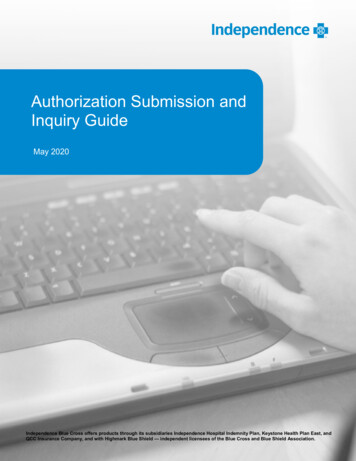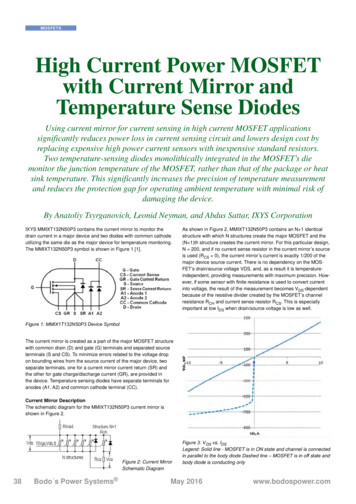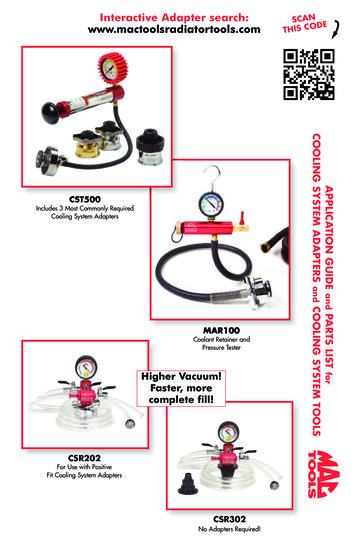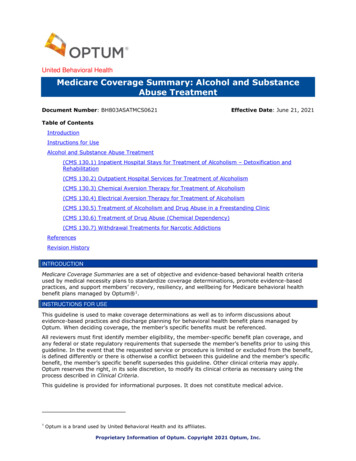
Transcription
Current (and Future?)Treatment of ChildrenWith IDDMBernard M. Degnan, MDPediatric EndocrinologyAscension St. John Health System
Financial DisclosureTHE ENDO GUYPRESENTATION
Some definitions Diabetes: to pass through Mellitus : sweet (from the Greek word for honey) Insipidus: having no taste Guess how ancient Greek doctors distinguishedbetween diabetes mellitus and diabetes insipidus?
Insulin Physiology Effects Protein: Anabolic- enhances muscle amino aciduptake (especially branched chain AAs) Carbohydrate: Inhibits glycolysis, and stimulatesglucose uptake in adipose, muscle, splanchnictissues Fat: Inhibits hormone-sensitive lipase, stimulatesfree fatty acid uptake, and inhibits ketogenesis inliver
Effects and Symptoms of Insulin Deficiency Hyperglycemia: weight loss, polyphagia,polyuria/polydypsia. Irritability, headache are common Ketosis and/or ketoacidosis (DKA): abdominal pain,nausea, vomiting, sweet breath (acetone formed viaAcetoacetate), dyspnea / Kussmaul respiration Muscle Breakdown for Glucose substrate: weakness, illappearance
Diabetes in the US 8.5% of US population has type 2 diabetes 0.4% have type 1 diabetes (just under 1 million) Type 1 diabetes accounts for 2/3 of children 20 with diabetes(80% 10 yo)
HOW DO WE TAKE CARE OF THIS? INTENSIVE INSULIN THERAPY– 1980’s : two shots a day with NPH / Regular or maybeLente or Ultralente– 1990’s : HUMALOG led to more frequent shots(lunchtime) and insulin pump therapy– 2000’s : Lantus use leads to initiation of intensivetherapy at diagnosis
Physiological Serum InsulinSecretion ProfilePlasma insulin 00Time20:0024:004:008:00
Relative Risk of Progression ofDiabetes Complications 1011Mean A1CDCCT Research Group, N Engl J Med 1993, 329:977-986.12
Lifetime Benefits ofIntensive Therapy (DCCT) Gain of 15.3 years of complication freeliving compared to conventional therapy Gain of 5.1 years of life compared toconventional therapyDCCT Study Group, JAMA 1996, 276:1409-1415.
Lifetime Benefits ofIntensive Therapy (DCCT) Reduce the risk of eye damage by more than 75 percent Reduce the risk of nerve damage by 60 percent Prevent or slow the progression of kidney disease by50 percent Reduce the risk of diabetes-related heart attack andstroke by 50 percent
DCCT and EDIC Epidemiology of Diabetes Interventions andComplications (EDIC) study, has continued to followDCCT participants for the last 20-plus years. EDIC hasshown that there are long-term benefits of early andintensive blood glucose control on the futuredevelopment of diabetes-related complications such asheart, eye, kidney, and nerve disease, and that earlyand intensive blood glucose control also lengthens life.
The Basal/Bolus Insulin Concept Basal insulin– Suppresses glucose production / releasebetween meals and overnight– 40% to 50% of daily needs Bolus insulin (mealtime)– Limits hyperglycemia after meals– Immediate rise and sharp peak at 1 hour– 10% to 20% of total daily insulin requirementat each meal
Basal/Bolus Treatment Program withRapid-acting and Long-acting AnalogsPlasma :00
Comparison of Human Insulins and AnalogsInsulinPreparationsOnset ofActionPeak (hr)Duration ofAction (hr)Lispro/Aspart/Glulisine* 5–15 min1–24–6Regular30–60 min2–46–10NPH1–2 hr4–810–20Glargine**1–2 hr“flat” 24Detemir***1–2 hr6-1212-24Degludec****1-2 hr“flat”48Hr?* “Rapid Insulin Analogs”-Lispro Humalog/Admelog, Aspart Novolog,FiaspGlulisine Apidra** Glargine Lantus, ***Detemir Levemir,****Degludec TresibaNote: Action of any insulin varies between and within people
New forms of Insulin in development Ultra-long lasting Ultra-short acting– Intradermal– Intraperitoneal Oral insulin: more likely beneficial for Type 2 Inhaled, intranasal Smart Insulin : “built-in” glucose sensors– Multi-valent glucose binding molecules
Inhaled Insulin
Starting MDI Starting total daily insulin dose is based onweight0.2 to 1.0 x wgt. in kg Units / day Bolus dose (aspart/lispro/glulusine) 20% ofstarting dose at each meal Basal dose (glargine) 40-50% of starting doseat bedtime or in AM (same time each day)
Estimating theInsulin to Carbohydrate RatioTDD Total Daily DoseUse the “500 Rule”Insulin / Carb 500 / TDDAnywhere from 5 to 40 g carb is covered by 1unit of insulinIn younger children, the ratio needed isusually higher than the formula predicts
Correction Bolus (for high glucose) Must determine how much glucose is lowered by 1 unit ofshort- or rapid-acting insulin This number is known as the correction factor (CF) orinsulin sensitivity factor (ISF) Use the 1800 rule to estimate the CF CF 1800 divided by the total daily dose (TDD)ex: if TDD 36 units, then CF 1800/36 50meaning 1 unit will lower the BG 50 mg/dlIn younger children, the correction factor is often higherthan the 1800 rule predicts due to increased sensitivity
Insulin Pens
Pump Infusion Sets
Variable Basal Rate: CSII ProgramPlasma insulinBreakfastLunchBolusDinnerBolusBolusBasal infusion4:008:0012:0016:00Time20:0024:004:008:00
Insulin Pump Profiles Basal rates Carb Ratios– 12 AM 0.8 Units/hr– 12 AM 20–3 AM 1.0 Units/hr––9 AM 0.7 Units/hr– 10 AM 15–6 PM 0.9 Units/hr–5 PM 15–9 PM 20 Target– 12 AM 100-1506 AM 12 Sensitivity / Correction–6 AM 90-120– 12 AM 60–9 PM 100-150–6 AM 50–9 PM 60
Insulin Pump instead of Syringe/Vial or PenIImproved accuracy vs. syringes / Pens:Insulin Pumps allow for much more flexible dosing, reduced risk ofhypoglycemia; pens give 0.5 Unit increments at mostPrecise insulin delivery (basal rates as low as 0.025 U/hr, boluses to nearest0.1 unit)Multiple basal profiles possible: adjust for sick day, exercise, shift hours, etc.Extended boluses (“slow-release insulin dose”) for high fat and high proteinmeals, or more than one bolus per meal Bolus calculators– Once programmed with insulin to carbohydrate ratio (ICR) andCorrection factor (CF), mistakes are minimized in dose calculation– Insulin on Board Feature: designed to eliminate insulin dose stacking
Continuous Glucose Monitor 3 basic components– Sensor creates the signal (electric current is created based on how muchglucose is present)– Transmitter plugs into the sensor and sends the signal through the air– Receiver shows the signal in a number or graph format: Insulin pump (Medtronic 530G, t:slim G4, Animas Vibe) Separate receiver (Dexcom G4 or G5 Mobile) or iPhone / Android (soon)(Dexcom G5 Mobile) Remote viewing after data is sent to the “cloud”
CGM is not the same as BG monitoring
Medtronic Enlite Sensor
Guardian Connect CGM System from Medtronic1. Guardian Connect App: glucose readings every 5minutes, readout on a smartphone2. Guardian Sensor 3 and Guardian ConnectTransmitter. Sensor usable up to seven days with aBluetooth transmitter3. Automatic uploads to CareLink account; easilyaccessed on the website.4. Smart technology to predict where glucose levelsare headed, the system alerts patients from 10 to 60minutes before a glucose excursion, so they can takeaction in advance.5. Sugar.IQ Intelligent diabetes assistant app.Uses IBM Watson technology. Reveals hiddenpatterns to provide personalized insights to helppatients make smarter decisions.6. Does not replace finger pokes for dosing
Dexcom G61.2.3.4.5.6.9.No Fingersticks needed unlesssuspected to be inaccurateSmart Device compatibleShare data with up to 5 followersFDA indication: 2 years old10 day wear, auto shutdownNo longer contraindicated withacetaminophenWe are not allowing phones atcamp
CGM Glucose Trend ArrowsDexcomMedtronicG4/G5 PhoneReceiver AppConstant: glucose is steady(not increasing/decreasingmore than 1 mg/dL/min).Slowly rising: glucose isrising 1-2 mg/dL/minConstant: glucose is steady (notincreasing/decreasing more than 1mg/dL/min).Rising: glucose is rising 1-2 mg/dL/minRising: glucose is rising 2-3mg/dL/minRapidly rising: glucose is rising morethan 2 mg/dL/minRapidly rising: glucose isrising more than 3 mg/dL/minFalling: glucose is falling 1-2mg/dL/minSlowly falling: glucose isfalling 1-2 mg/dL/minFalling: glucose is falling 2-3mg/dL/minRapidly falling: Your glucoseis falling more than 3mg/dL/minRapidly falling: glucose is falling morethan 2 mg/dL/min
Freestyle Libre Less expensive 1 hour “warm up” No calibrations needed 14 day wear You must request (swipe) thedata NO ALARMS
Users can download an app to iPhone to use the phoneas the scanner! FreeStyle LibreLink
Medtronic 670G
T-Slim X from Tandem
The Omnipod : Dash and HorizonDistinguishing Features:1. The New Pod is 34%smaller, 25% lighter and16% slimmer2. Tubeless with a wirelessPersonal DiabetesManager (PDM)3. Waterproof4. Hands-free, automatedinsertion and priming —minimizes hassles anderrors5. Built-in FreeStyle meter6. Food library of over 1,000common foods
The next step: Closed LoopAll pumps aredeveloping“personalized” dietarydosing software fortheir hybrid pumps(4 years?)Internalization?
This stuff works! Continuous Glucose Monitoring Associated With Less Diabetes-Specific Emotional Distressand Lower A1c Among Adolescents With Type 1 Diabetes, Anthony T. Vesco, Aneta M.Jedraszko, Kimberly P. Garza, Jill Weissberg-Benchel, J Diabetes Sci Technol. 2018 Jul;12(4): 792–799 Metrics Beyond Hemoglobin A1C in Diabetes Management: Time in Range, Hypoglycemia,and Other Parameters, Lorena Alarcon-Casas Wright, MD, FACE and Irl B. Hirsch, MD,Diabetes Technol Ther. 2017 May 1; 19(Suppl 2): S-16–S-26 Deiss et al, Improved Glycemic Control in Poorly Controlled Patients with Type 1 DiabetesUsing Real-Time continuous Glucose Monitoring, Diabetes Care 2006 29: 2730-2732 Bergenstal Et al. Effectiveness of Sensor Augmented Insulin pump Therapy. NEJM 2010 Del Favero S, Boscari F, Messori M, et al. Randomized Summer Camp Crossover Trial in 5- to9-Year-Old Children: Outpatient Wearable Artificial Pancreas Is Feasible and Safe. DiabetesCare 2016; 39:1180. Zabeen B, Craig ME, Virk SA, et al. Insulin Pump Therapy Is Associated with Lower Rates ofRetinopathy and Peripheral Nerve Abnormality. PLoS One 2016; 11:e0153033.
Psychosocial Aspects of Type 1 DiabetesDiabetes Care. 2007 Oct;30(10):2716-24. Epub 2007 Jul 20.Routine psychological screening in youth with type 1 diabetes and their parents:a notion whose time has come?Cameron FJ1, Northam EA, Ambler GR, Daneman D.Pediatr Diabetes. 2009 Sep;10 Suppl 12:175-84. doi: 10.1111/j.13995448.2009.00580.x.Psychological care of children and adolescents with diabetes.Delamater AM1
School Performance and Type 1 DiabetesEffect of type 1 diabetes on school performance in a dynamic world: new analysis exploring Swedishregister dataEmma Persson, Sofie Persson, Ulf-G. Gerdtham, Katarina Steen Carlsson & for the Swedish ChildhoodDiabetes Study GroupPages 2606-2622 Published online: 23 Dec 2018Download citation ACTThis paper investigates if the effect of type 1 diabetes mellitus (T1DM) on school performance,documented in prior research, has changed in more recent birth cohorts of children using nationalSwedish population register data. The issue is of interest because management and treatment of thedisease have improved over the last decades and, furthermore, because of changes in the educationalgrading system. Despite these changes, data indicate a persistent negative effect of T1DM oncompulsory and upper secondary school grades with a standardized effect size of 0.109 and 0.070,respectively, and the results appear only marginally smaller compared to earlier findings in cohortscompleting school under the previous grading system. Moreover, the results are consistent foralternative model specifications and econometric estimation strategies. Whereas access to newtreatment technologies and improved diabetes management strategies has reduced the burden ofdiabetes in daily life, the results from this study indicate that continued efforts are needed to improvethe situation in school for children with T1DM to prevent potential long-term socio-economicconsequences.
Insulin Pump:– 5-7,000 for the pump– 100-200 pre month for infusion sets Continuous glucose sensor:– Transmitter: 240 (lasts 6-12 months)– Sensors: 120 each (1 per week)
Libre Scanner: 60-70– App available on I-Phones, can use as scanner Sensors: 50 each (last 2 weeks)
PICU hospitalization for DKA: 12,000 One year of renal dialysis: 53,000
Access to care and technology
Future Topics (No time today ) Use of sensor / pump technology in hospital /procedures New onset: in or outpatient? Starting sensor and/or pump right away
Extended boluses ("slow-release insulin dose") for high fat and high protein meals, or more than one bolus per meal Bolus calculators - Once programmed with insulin to carbohydrate ratio (ICR) and Correction factor (CF), mistakes are minimized in dose calculation - Insulin on Board Feature: designed to eliminate insulin dose stacking











